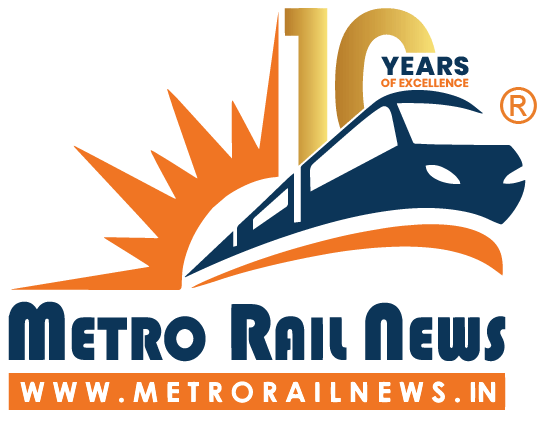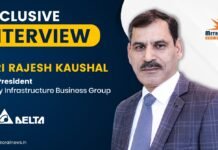Metro Rail News team conducted an exclusive interview with Mr. Shree Harsha, Global Sales Strategy Director – Supply Chain & Logistic, Dassault Systemes
Shree Harsha is an accomplished professional with over two decades of experience in international business consulting, management consulting, technical expertise, and sales and marketing. Currently serving as the Logistics & Supply Chain Global Sales Strategy Director at Dassault Systemes, he has played a crucial role in developing sustainable innovations aligned with the UN Sustainable Development Goals. He has worked extensively with companies in India and across the globe, including strategic customers in Japan, China, Germany, France, and North America.
Narendra Shah: What have been the major solutions and brands for Dassault Systemes in recent times, being a pioneer for 3D product design, simulation, manufacturing and other 3D-related products?
Shree Harsha: Dassault Systemes have been in India for a quite a long time now. We call ourselves as the 3DEXPERIENCE Company with a mission to build the entire economic, value creation process using the Dassault Systemes product portfolio. We call it as virtual universes, and we work towards building virtual universes for manufacturing infrastructure and life sciences sector. That is how we look at the business at a very macro level.
We are a French-listed company, and we have been in India for almost 20 plus years now. We have a significant presence in India with more than six office locations across the country, with headquarters in Bangalore and Delhi and R&D labs in Pune and Bangalore. For proximity towards the customer, we have offices in Ahmedabad, Calcutta, Chennai, Bangalore, Mumbai and Pune. We are growing in India, and we have roughly around 4,000 plus people currently working in the country with the second largest user base after Paris. We are around 5.5 billion Euro revenue company with the business interest across different industries. Railways and Ports are two industries which cover us with most of the things around logistics. So, logistics is one of the core businesses for us in the way we cater to our customers, and therefore, we feel really proud to be associated with different logistics projects in India today, especially the GatiShakti project. The ambition of the Gatishakti is to reduce the cost associated with logistics when compared with the percentage of GDP ranging from 14% to 18%.
This is happening through better coordination, better alignment with regard to clearances of the processes, and making sure that there are less bottlenecks with regard to the delays for the clearances from one department to the other in getting approvals. We believe in having a single repository of information like single source of truth, what we generally refer to as a 3DEXPERIENCE platform to build the entire logistics virtual twin to be able to cater to the needs of rail and ocean freight, trucking, last mile connectivity and primarily what is referred to as intermodal logistics which is basically multimodal logistics with urban planning done in a better fashion.
If one wants to send goods today from point A to point B, many customers may not opt for one route. In this situation, we provide a virtual twin platform for them to able to plan, simulate, optimise and to be able to deliver these experiences to the customers using a 3DEXPERIENCE platform. That’s our larger ambition in the way, what we cater to the market.
Narendra Shah: Being a French company, what is the Dassault’s vision and mission in India?
Shree Harsha: Our primary mission is to make sure that our customers, in their journey of innovation, work with Dassault Systemes in their product development strategy. We help our customers build better experiences eventually for their customers. We do that through our 3DEXPERIENCE universes, which enable to innovate better, reduce cost and optimise the working efficiency of the interdepartmental workflow together so that the customers acknowledge and remember the services and products that are delivered in a better fashion. We do that by having long-term partnerships with our customers. We build relationships for five, ten, fifteen-year horizons, and some of the relationships we have with companies like Boeing, for an example, have been for more than the last thirty, forty years. We are working very closely with almost 10,000 plus Indian customers today. Globally, we are around more than three lakh customers using Dassault Systemes products.
In India, we are also working quite closely with academic institutes. It means we have more than 1000 finer education institutes teaching Dassault Systemes product portfolio every day, along with the domain skill sets necessary. We align with the national agenda of skill development in India, which is the first aspect. The second alignment is that we work very closely with the start-ups in India through our 3DEXPERIENCE lab, which is our start-up incubator.
We support the Indian start-ups in various business sub-segments so that, they provide the most innovative products which are sustainable, take lesser resources and have minimal carbon footprints to make sure that we help in the course of making India and designing India through this journey. We are very much focused in aerospace, defence, automotive and industrial equipment. That’s our core bread and butter in terms of revenues. While we are diversifying quite a lot into CPGR, which is consumer package goods and retail, we are into high-tech businesses because of the new interests in terms of the new economy which we see in India.
The last one is the business services. We are witnessing huge investments coming in the logistics aspect in the Indian economy assets. Hence, we work, bring in our knowledge and expertise and help Indian customers to build better products and services and use lesser resources so that they are much more sustainable in their innovation journeys.
Narendra Shah: Especially for the transportation sector like metros and railways, what have been the biggest achievements so far being the global sales strategy director of supply chain and logistics at Dassault system?
Shree Harsha: At a very macro level for railways and rail business, we have two sites of the business operations. One at the upfront, which is the design and the manufacturing of the rail components, the rail coaches, the rolling stock, the infrastructure and the interiors. Most of the companies like Alstom, Rotem, and Bombardier, who are supplying these coaches to Indian railways, use Dassault Systemes tool sets to design, manufacture, and do the quality checks and balances. They use AR, VR and use digital twins to deliver the best quality product at the right time and price for Indian railways to leapfrog in railway investments and go best in world-class in whatever expenditure is being made. Whether it is electric trains, new investments coming in hydrogen-based locomotives and trains, we are amongst the cutting-edge technology research projects today which are working with quite a lot of Indian business units under railways helping them to localise their components in their design and manufacturing journey. That’s the upstream of it.
The downstream of it is the rail freight operations. It is the most profitable business for Indian railways. Nearly eighty per cent of Indian rail revenue comes from its freight operations. If we look at what is being transported by freight trains in India, we’ll see that sixty to seventy per cent is chemicals, coal and a little bit of automotive. The challenge with freight operations in India lies across its more than 68,000 kilometres of railway tracks to transfer the goods from point A to point B, with a number of constraints like passenger and goods train running on the same track.
We are, therefore, working closely in solving these kinds of complex operational research challenges. We help not only railways in solving these kinds of complex logistics puzzles worldwide but different companies in freight, crew, service requirement or the entire intermodal planning of the marshalling and managing the railway yards and even managing the connectivity across all of these together.
Globally, we work with quite a lot of players who are leaders in this particular segment, and we’re trying to bring this sort of technology so that we can help Indian railways to maximise the revenue, reduce the operational cost, improve safety elements and get much more confidence on their maintenance activity because we are in the journey of helping customers in the predictive maintenance as well.
Narendra Shah: You have 3DEXPERIENCE platform. Could you please explain how it can be beneficial for the Metro Rail operators in our country?
Shree Harsha: A 3DEXPERIENCE platform specifically is a business experience platform. It connects the various stakeholders in any business function to be able to streamline them and perform day-to-day activities.
Coming to the Metros as a specific example, when we look at a metro line being developed in a city, we find there are a number of processes associated with it. Somebody needs to look at the city’s urban planning environment, envisage the key congestion location, identify the areas where the Metro line and stations need to be created and then create a DPR, a detailed project report.
We help our customers with all these planning activities. An example that we have with us is Singapore, where we worked quite closely in these kinds of urban planning scenarios in terms of identifying the locations, the areas where the metro lines could be put up and other planning activities. In India, we have worked quite closely with Jaipur Urban Development Authority in doing this sort of urban planning. So, developing a metro system, once we have a DPR, a model in our mind, then we need to visualise the number of lines and stations needed for the Metro, the signalling and the various other aspects. Thereafter, one needs to create a project report for it and look for a tender process to be able to procure the rolling stock like coaches. So, we need to create that specification document which we are helping many of the customers worldwide to build in 3D so that there is no confusion regarding the specification of the Metro Systems being developed.
Once that’s done, companies who bid for this project may deliver the bridges, the quotation for station construction, rolling stock and locomotives, and then finally, we have an operational metro train available. Then comes workforce management. How to manage the workforce for the operational Metro system, manage the timetable, the service timetable and the maintenance schedule of the Metro are the areas where we help the metro operators. Some lines may break, some repairs might come in and the rail operators need to rearrange the line accordingly and also see if there is a spare locomotive available. So, the operational aspects of running a metro line are the areas which we take care of using our platforms for the customers. We have the de facto partner in rail systems worldwide because customers see us as a partner of choice in their journey of technology and operational efficiency improvement, and that’s exactly what we’re trying to do in India.
Narendra Shah: What are the latest trends in the transportation and mobility industry? Seeing the rapid urbanisation of cities globally, what can be the best approach to sustainable public transport systems?
Shree Harsha: It’s a valid question. Sustainability is at the heart of Dassault Systemes‘ product vision strategy and our operations. In fact, we have declared our science-based target initiatives on even reducing our own CO2 emissions with regard to our day-to-day operations. We are on par aligned with the UN sustainable development goals on the journey of sustainability and helping many of our customers in their sustainable journey as well. We are a trusted partner of our customers in this segment. The three areas where we help our customers with sustainability are product, process and operations. Any company which manufactures goods uses a lot of raw material, water, energy etc. We help them to reduce it using our software so that they are able to manufacture the goods and convert the raw materials used by them into final product by using lesser energy. Second, comes the process. When we say process, it means the various steps involved in converting raw material into a finished good or a product. Let’s say, raw steel to the final product as an output. During the process, there are a lot of non-value-adding activities, inefficiencies, energy consumptions etc. going on as a part of the process. It is where we help our customers. We have complete tool sets to help our customers navigate their sustainability charter altogether. That’s number two.
Last but not the least is the operations. If calculated, we see that sixty per cent of the cost involves energy consumption while sending the goods through ship, train or trucks based on fossil fuels. This can be improved. We help our customers to make this kind of informed decision so that they can optimise the transport making the travel much more sustainable. During the course of the journey, if someone doesn’t want to use the fossil fuel and wants to switch to electric, we help the customers in their transition towards the electrification journey. That’s a valid aspect of our sustainability goal. So very importantly, we are the leaders in the sustainable journey for many of our customers worldwide.
Narendra Shah: The Indian government is making huge investments on the transport and infrastructure development. What are the major products and customised solutions offered by Dassault Systemes?
Shree Harsha: Seeing the huge investment the Indian government is making, especially in the projects like GatiShakti and different aspects in which the Indian infrastructure currently lacks, we are trying to help build India’s virtual twin of logistics so that we have the most efficient successful logistics network in India in compliance with all the safety and the regulatory norms associated with the government departments.
The safety and regulatory norms can be related to safety & signalling and warehouses which is being built across Pan India. We even help managing and digitising various constraints being faced by different sectors in India and optimise everything around. So that we get the most optimised roads, freight, and workforce, which helps in the direction of reducing the logistics cost to the 8% of the GDP. We are the technology partner of choice for most of the companies in this logistics segment, and we want to bring that to India and be partnered with this journey which we are trying to achieve by 2030. This is what, in brief, for our major products and customised solutions.
Narendra Shah: In what ways virtual twin is different from digital twin? What are the major sectors that benefitted from the technology to provide multidisciplinary and multiscale solutions?
Shree Harsha: More and more world today is changing towards what we call a cyber-physical system. It technically means multidiscipline, mechatronic-centric subsystems, and we are developing Dassault Systemes tool sets, the CATIA apps available with us and the design apps on top of the 3DEXPERIENCE platform, which is helping in model-based systems, engineering to build cyber-physical systems.
We presently are leaders in the model-based systems engineering space worldwide with our Catia portfolio, which is the de facto tool globally for any high-tech design. Nearly ninety per cent of the cars and almost ninety-five per cent of the planes are designed using the Catia tool sets, which we are trying to see how we can further work on it. We are also working with logistics twin, which we pioneer with our systems and multidiscipline systems engineering approach altogether.
Connecting back to what’s being said earlier, i.e., the difference between the Virtual Twin and the Digital Twin, I would say that both technologies are quite similar with respect to the multidiscipline systems engineering approach. Digital twin can be just a 3D representation of any particular object. With virtual twins, we have various additional elements associated. We can have the behaviour element, the time element and the schedule element associated with it so that it is much more reactive to data and insights, and it can also learn automatically with artificial intelligence and machine learning. Learning through the real-time environment, we apply to the virtual so that we are much more confident in the way we deliver the outcomes of execution.
Narendra Shah: What are the complete advantages of being with the Dassault systemes compared with the other companies in the market in the same domain?
Shree Harsha: Dassault Systemes is a long-term thinking company considering the way we operate and work with our customers. We have a very unique value engagement consultative approach with our customers. We sell a product portfolio for a particular need in the market where we understand the challenges faced by the customers and help them charter their digital journey. We put up a roadmap of a few years and have some key milestones with the right KPIs in place so that we can realise the ROI for the technology investments.
Defining the roadmap together with the customer, we see the success, and then we go into the much larger scale in terms of deployment. Many customers in India, like Ashok Leyland, Eicher Motors, and Mahindra, have been with us for more than twenty years. So, our partnering with major companies for technology and other support for a longer period has been one of our major achievements and key difference which keeps us apart from other companies.
The other one I would say is, we are the only company in the world to provide a 3DEXPERIENCE platform with all the apps, which gives a modular approach to our clients so that they can scale up their technology investments. It means that our clients can address different challenges simultaneously. Challenges in manufacturing, design, sales, operational efficiency and others can be addressed and scaled up to a higher level. Most of the companies like Renault in India, Alstom worldwide use our system tool sets for the design and development of their products. So, we can say that we are the leaders in this particular space and we are a kind of innovation partner for many of our customers, being with them in the journey of digitisation.
Narendra Shah: Any message for our readers? We would also like to know your views on our magazine.
Shree Harsha: I follow your magazine. I think you guys are doing a fantastic work with regard to three things. Number one, you are delivering the best news on various sets of investments, which is quite beneficial for companies like us and also for people, academic institutes and for students as well. That’s a fantastic job, and I should really congratulate you for the work you’re doing.
And number two, I think you’re also helping quite a lot of new companies which are trying to enter India because this is the most happening industry presently. The metros, the railways, track maintenance, and the infrastructure are supposed to be the most promising industries today. You have a wealth of knowledge to share with a lot of companies coming to India. So, hats off and thank you for your efforts. And last but not the least, I think you people are also building awareness about this sector which is quite promising and disseminating the message that India, in its Amrutkal and development spree, will have a lot of investment in infrastructure, and there would be new opportunities, emerging opportunities in the area of infrastructure.
Also, thanks to your website, which many people are discovering for their information. So, we shall be really happy to contribute in any way possible with our use cases and case studies, which can be beneficial for your readers.
Narendra Shah: Thank you so much for your kind words, and we’ll try to give our best in terms of information that can be authentic and that can be without any influence. We do provide the services to the people who want to set up the businesses in India through our information dissemination approach and event platforms. So, we owe our commitment to try and bring forward the best job in the market today, across the industry and various people around. Thank you for your time.








